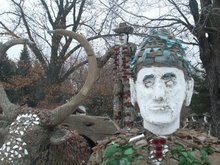Driving down the streets and thoroughfares of Djibouti City, and my primary thought was, “I’ve seen all of this before”. I’ve never been in this particular filthy municipality before, but I have been to markedly similar places. Drive down a dusty track in the Third World, and you’ll see bare footed men and women. Some working, some walking, some just hanging out in whatever shade is available. Nobody’s moving too quickly. Along the road, enterprising people vend their wares from carts or ramshackle shacks located against the tall, concrete, broken glass topped walls of the more land-rich locals.
Aging whitewash is the dominant color, with accents of sky blue paint on the walls or doors. Peeling, hand painted signs advertise each small business. The men are in t-shirts – some with slacks, others in sarongs. The women are the most colorful things on the street, wrapped top to ankle in bright prints of all colors – huge flowers, manic patterns – almost a strain on the eyes.
We turn briefly towards and adjacent to the local market. Greg supposes it’s the flea market. I suppose that there’re plenty of fleas, but that it’s just a market. We pass by big piles of various fruits in crates and pyramidal displays under the ubiquitous blue tarps. From the perimeter, you can smell the rest of the market, a mix of humanity, their waste, and rotting food. This place looks much nicer than it smells.
Most of the streets are paved, and main streets are in much better shape than side roads and backroads. Downtown, building construction is mostly concrete framed with block infill, plastered and painted. Large arches are common, as are shaded, inset balconies. Otherwise, there’s little architectural consistency, unless Colonial/French/Mediterranean/Arabic/African is a consistent architectural style. It looks like maintenance activities stopped upon building occupation, and I can only imagine the broken tiles and fixtures within.
Mature and chaotic street trees line some of the roads downtown, providing more vital shade. Downtown is deserted at this time of day, the siesta period between noon and two or three or so, so we don’t struggle too much with the traffic.
Three dashed white lines, spaced at three or four meters, run the length of most of the major roads. Under light traffic, opposing traffic straddles the outside lines (like 1:1 scale slot cars), saving the inside line for overtaking. When traffic picks up, all bets are off, and you drive anywhere you want.
So we wanted to drive to the Kempinski Hotel, ostensibly to check out their superior landscaping, but mostly to have a cold beer. Even though I’d never been there before, I’d been there before, as the Kempinski is that secure, luxurious Western hotel that locals cannot near afford that exists in most every backwater capital city. Uniformed staff met us at the gate, then later at the door to guide us through their security procedures and we soon found some shaded seats near their infinity pool to suck down a couple of well cold, eight dollar Heinekens.
What’s not to love about this place?
2009-11-05
Djiboutitown
Subscribe to:
Post Comments (Atom)




1 comment:
From the Wikipedia article about Kempinski Hotels: "Today, Kempinski is majority owned by the Crown Property Bureau of Thailand."
Personal property of the King of Thailand, the richest monarch in the world. What would Lyndon LaRouche say? Something incoherent but entertaining, I'm sure.
Post a Comment